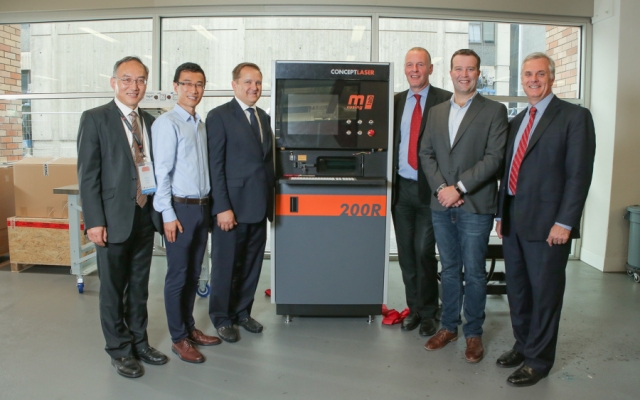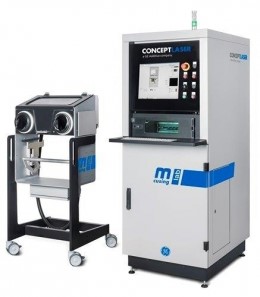
UNSW students, staff and industry partners have been handed a unique opportunity to explore the exciting world of additive manufacturing (otherwise known as 3D printing), with the arrival of a sophisticated metal 3D printing machine under an initiative by digital industrial giant GE Global.The 3D printer, worth $350,000, was unveiled in the School of Mechanical and Manufacturing Engineering (MME) in November 2017 and has led to an upsurge in interest within the Faculty. Professor Chun Wang, Head of MME, talks about the future of 3D printing at the School.
Have you taken off all the wrappings and started work?
Not quite yet, although I can’t wait to try it. The 3D printer requires a specialised air-conditioned space so we are currently fitting out a dedicated laboratory. Everything should be installed and ready to go by the middle of this year when we can officially open the UNSW Additive Manufacturing Laboratory.
The great news is that once we had been selected to receive the 3D printer from GE Global, the Faculty announced funding to purchase an additional 3D printer. This new machine is a little more powerful at 400-watts and the build size is a little larger. It also has the ability to mount external devices which means we can do in-situ quality assurance monitoring.
Most significantly, two 3D printers give us the capacity to handle more research, more industry collaborations and the large number of students I’m anticipating enrolling in the brand-new course we’re developing.
What’s the new course and when will it start?
The new course in additive manufacturing technology will be offered to fourth-year students and also postgraduate students (by coursework) in the second half of 2018. Interestingly, our postgraduate student enrolment has skyrocketed recently, and this course will be very attractive to those students.
What about research?
In research, there are many things we could look into, but we are already discussing a collaborative research project between Engineering and Medicine to develop novel spinal fusion devices to overcome the current clinical problem of poor bone ingrowth into fusion devices.
We are also hoping to win a research grant in collaboration with some colleagues at Stanford in the US to develop in-situ characterisation of microscopic defects in additive manufacturing. If we are successful, that will be a very large research program.
It’s a great opportunity to strengthen the ongoing collaboration between UNSW and GE Global, who are now the largest additive manufacturing company globally
Professor Chun Wang, Head of UNSW Mechanical and Manufacturing Engineering
Is this just the start? Do you have a big-ticket item you’d like to purchase?
We have big plans for the lab. In the long run, I’d like an even larger machine so we can bridge the gap between university research and what companies need in terms of commercialisation. This would mean a machine with a build area 10-20 times larger than the machines we have, and would certainly cost a lot more money, but that is the long-term plan.
You mentioned the lab would be open to industry, does this include UNSW Engineering alumni?
Yes, definitely. We invite any interested alumni, from those setting up their own startup to those working in large companies, to come to the lab and explore research and/or product development possibilities with us.
In addition to the commercial 3D printers, we also have research staff in the School developing micro and nano additive manufacturing technologies that could potentially be turned into machines in the future. We would welcome any conversations with potential industry partners along those lines.
What are you personally most excited about in setting up the new lab?
It’s a great opportunity to strengthen the ongoing collaboration between UNSW and GE Global, who are now the largest additive manufacturing company in the world.
GE Global are taking a significant leadership role in promoting the use of 3D printing, both in industry and education. They are investing $US10 million globally over the next five years to create a pipeline of additive manufacturing experts to accelerate advanced manufacturing and I am very happy and excited to be part of that global team.
FACT BOX
System specs and uses
The 3D printers in the Additive Manufacturing Laboratory incorporate a laser powder-bed fusion system designed to manufacture metal components with elaborate structures and parts made from reactive materials like titanium. They are ideally suited to fine detail, high-quality surface finish, and precision component structures and will be used for the following research areas at the frontier of additive manufacturing:
- Final part production and improvement of tolerances and surface finish
- Design and development of new materials, including light-weight and low-cost materials, suitable for additive manufacturing
- Design, optimisation and fabrication of various metal parts with functional gradient microstructure, complex geometry or optimised topology design
- Simulation of the additive manufacturing process to understand and improve the manufacturing process.
If you’d like more information, please contact Chun Wang: chun.h.wang@unsw.edu.au
Written by: Penny Jones
